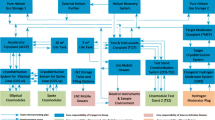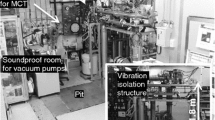Abstract
Today almost a quarter of all neutron scattering experiments performed at neutron scattering facilities require sample temperatures below 2 K. However, a global shortage of helium gas can seriously jeopardise low temperature experimental programmes at neutron scattering laboratories. Luckily the progress in cryo-cooler technology offers a new generation of cryogenic systems with significantly reduced consumption and in some cases nearly a complete elimination of cryogens. Here we discuss design and test results of a new cryogen free top-loading cryostat developed through an ISIS and Oxford Instruments collaborative project. The cryostat provides neutron scattering sample environment in the temperature range 1.4–300 K. High cooling power (0.23 W at temperature less than 2 K) achieved at the cryostat’s variable temperature insert heat exchanger allows operation of a standard dilution refrigerator insert in a continuous regime. From a user perspective, the system offers operating parameters very similar to those of an Orange cryostat but without the complication of cryogens.




Similar content being viewed by others
Notes
ISIS—pulsed neutron and muon source at the Rutherford Appleton Laboratory in Oxfordshire, UK, operated by STFC.
Abbreviations
- ULT::
-
ultra low temperature
- SE::
-
sample environment
- PTR::
-
pulse tube refrigerator
- VTI::
-
variable temperature insert
References
O. Kirichek, Impact of the cryogen free revolution on neutron scattering laboratories. Mod. Phys. Lett. B 26, 1230006 (2012)
D. Brochier, Ill. Tech. Rep. 77, 74 (1977)
T. Feder, Government handling of helium gets report card: think again. Phys. Today 3, 28 (2010)
B.E. Evans, R.B.E. Down, J. Keeping, O. Kirichek, Z.A. Bowden, Cryogen-free low temperature sample environment for neutron scattering based on pulse tube refrigeration. Meas. Sci. Technol. 19, 034018 (2008)
O. Kirichek, P. Carr, C. Johnson, M. Atrey, Nuclear magnetic resonance magnet actively cooled by pulse tube refrigerator. Rev. Sci. Instrum. 76, 055104 (2005)
C. Wang, Helium liquefaction with a 4 K pulse tube cryocooler. Cryogenics 41, 491 (2001)
C.R. Chapman, B.E. Evans, M.P. Dudman, J. Keeping, R.B.E. Down, O. Kirichek, Z.A. Bowden, Cryogen-free cryostat for neutron scattering sample environment. Cryogenics 51, 146 (2011)
O. Kirichek, B.E. Evans, R.B.E. Down, Z.A. Bowden, Cryogen free low temperature sample environment for neutron scattering experiments. J. Phys. Conf. Ser. 150, 012022 (2009)
L.E. DeLong, O.G. Symko, J.C. Wheatley, Continuously operating 4He evaporation refrigerator. Rev. Sci. Instrum. 42, 147 (1971)
Acknowledgements
We are very grateful to members of the ISIS sample environment group involved in the ISIS cryogen free development project. We also greatly appreciate the fruitful collaboration with colleagues from Oxford Instruments.
Author information
Authors and Affiliations
Corresponding author
Rights and permissions
About this article
Cite this article
Kirichek, O., Foster, T.J., Down, R.B.E. et al. Top Loading Cryogen Free Cryostat for Low Temperature Sample Environment. J Low Temp Phys 171, 737–744 (2013). https://doi.org/10.1007/s10909-013-0858-x
Received:
Accepted:
Published:
Issue Date:
DOI: https://doi.org/10.1007/s10909-013-0858-x




